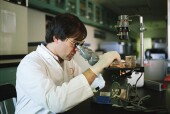- Skip Storing This Everyday Product in the Fridge Door
- Green Tea + B3 Pairing May Boost Brain Health
- Navigating Your Midlife Crisis: Embracing New Possibilities
- City Raccoons Showing Signs of Domestication
- Mapping the Exposome: Science Broadens Focus to Environmental Disease Triggers
- One Week Less on Social Media Linked to Better Mental Health
- Your Brain Changes in Stages as You Age, Study Finds
- Some Suicide Victims Show No Typical Warning Signs, Study Finds
- ByHeart Formula Faces Lawsuits After Babies Sickened With Botulism
- Switch to Vegan Diet Could Cut Your Greenhouse Gas Emissions in Half
Experimental Infertility Treatment Seems Effective, Cheaper


A crucial part of conventional in vitro fertilization (IVF) — the incubation of embryos in a laboratory dish — can instead take place in a device inside the vagina, new research suggests.
Scientists from the United States and Colombia contend that the device, called an INVOcell, might sharply cut costs for pricey IVF procedures among certain women. It could also make the technology more accessible to those who don’t live near big-city assisted reproduction centers, the researchers said.
In a small U.S. study, pregnancy rates were nearly identical between women whose eggs were conventionally incubated with sperm in the lab for five days and those whose eggs and sperm were placed in the INVOcell device for the same amount of time.
Once thought of as producing “test tube babies,” IVF is one of the most prominent forms of assisted reproduction and has been used in the United States since 1981. About 65,000 babies were born in the United States in 2012 through 176,000 assisted reproduction cycles, typically costing upwards of $10,000 apiece, according to the U.S. Centers for Disease Control and Prevention.
“One reason assisted reproduction is limited is because of cost, and part of that is the incubation systems we use … which are complex devices that require calibration and daily quality control checks,” said study author Dr. Kevin Doody, founder of the Center for Assisted Reproduction in Bedford, Texas.
“We think we’ve been able to simplify the IVF process to require minimal monitoring with a high pregnancy rate,” Doody added.
The research is scheduled for presentation Wednesday at the American Society for Reproductive Medicine meeting in Honolulu. Studies presented at scientific conferences typically have not been peer-reviewed or published, and results are considered preliminary.
Optimal candidates for the INVOcell technique are infertile women able to produce many viable eggs using ovulation-stimulating hormones, experts said.
Manufactured by INVO Bioscience of Medford, Mass., the small, cylindrical device can be held in place in the vagina with a diaphragm, where the vaginal environment is expected to maintain the right temperature, pH and other conditions necessary for fertilization and early embryo development. After three to five days, the device is removed and embryos can be recovered and transferred to the uterus.
Doody’s study divided 33 infertile women between ages 18 and 38 into two groups. After egg retrieval, each patient’s eggs were incubated in a petri dish with sperm for two to four hours, after which up to 10 eggs per patient were either placed in the INVOcell device or moved to the next stage of conventional lab incubation.
Embryos resulting from both methods were of comparable quality, and similar pregnancy rates resulted: 10 of 17 women from the INVOcell group and 10 of 16 from the incubator culture group reported ongoing pregnancies.
“My impression is wow, this is really interesting stuff,” said Dr. Timothy Hickman, chief of reproductive endocrinology at Houston Methodist Hospital in Texas. “IVF tends to be a highly complex process … and here’s a novel way to try to provide something for a certain population that can benefit. This is never going to replace an IVF lab, but maybe for a certain population it may work out right.”
A second study on the INVOcell device presented at the reproductive medicine meeting indicated that the technique is also effective when eggs need to be manually injected with sperm to achieve fertilization, a procedure called intracytoplasmic sperm injection.
Dr. Elkin Lucena, scientific director and founder of Colombian Fertility and Sterility Center in Bogota, led research on couples who underwent 172 cycles of IVF in which their embryos were incubated in the INVOcell device for three days, with an average of two embryos transferred into the uterus afterward. Pregnancy resulted in 40 percent of embryo transfers — roughly the same rate as conventional IVF.
“Especially from a psychological impact, couples feel they’re participating in conception too and carrying their own [offspring] inside of them instead of in a lab,” Lucena said. “And the cost is lowered a lot, which is making it easier for people to access these techniques.”
The INVOcell vaginal device, currently under review by the U.S. Food and Drug Administration, is already approved for use in Canada and several other countries.
Doody, who said he owns about $10,000 of publicly traded stock in INVO Bioscience, said he thinks using the device could halve the cost of a typical cycle of IVF treatment.
“My guess is that at least two-thirds of IVF patients could be treated with this type of [technique],” Doody said.
One difference between the conventional treatment and the INVOcell approach is that eggs and sperm are placed together in the intravaginal device before knowing if fertilization has occurred.
“That is a waiting game for the patient,” said Doody. “But in all the cycles we’ve done, we’ve not had any cases where we didn’t have embryos [created] to transfer back to the uterus,” he added.
More information
The U.S. National Library of Medicine has more about IVF.
Source: HealthDay
Copyright © 2025 HealthDay. All rights reserved.










